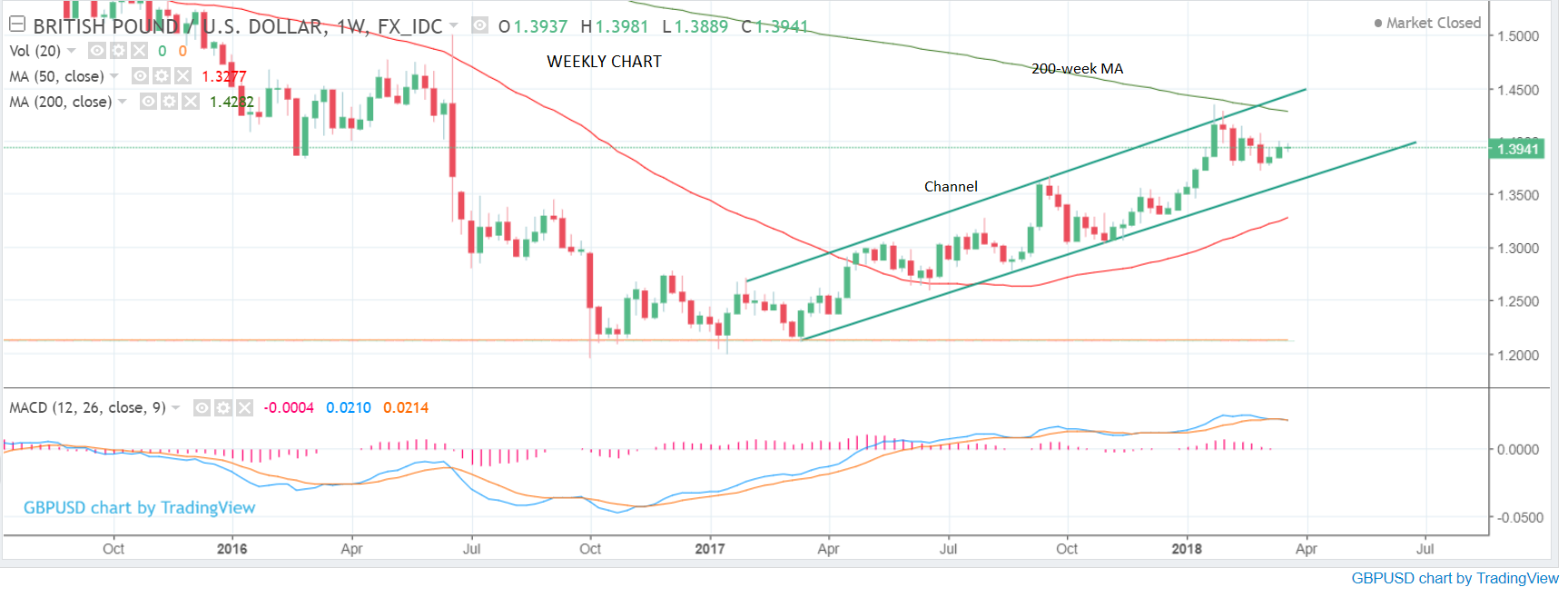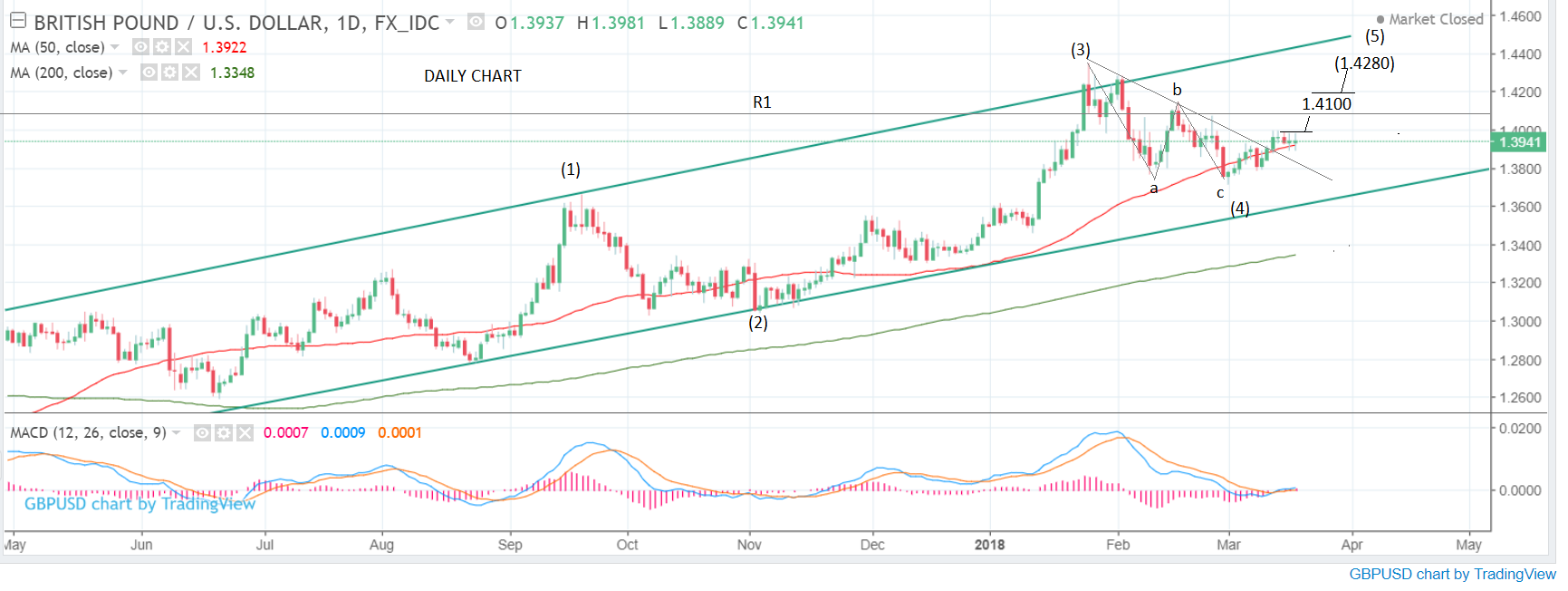Pound-to-Dollar Rate Forecast for the Week Ahead

© Chris Titze Imaging, Adobe Stock
The GBP/USD pair is expected to extend its uptrend to 1.4100 during the event-packed week ahead.
The Pound-to-Dollar exchange rate continues rising steadily in a channel on the weekly chart (see below) and given that its uptrend remains intact the overall forecast is for it to continue.
There is little change from the previous week's GBP/USD forecast except that we have lowered our upside target slightly.
The recent pull-back which occurred after the January 25 peak appears to have completed after bottoming at the 1.3712 lows.
The pair has started going higher again and closed out the week at 1.3941.
It has broken above a minor downsloping trendline drawn from the January 25 highs and connecting the B-wave peak of the ABC correction. This trendline was blocking upside progression in the 1.39's, but has now been broken, and this has increased the bullish outlook for the chart.
Overall, we expect the uptrend to continue, first to the monthly pivot at 1.4100, then to the 200-week moving average (MA) at 1.4280 and finally, probably, at least to the level of 1.4345 Jan highs.
A break above the current 1.4000 highs would signal more upside, first to 1.4100. A break then above 1.4140 would signal a continuation to 1.4280.
Only a break below the March lows at 1.3712 would suggest the beginnings of a new trend lower; whilst those lows hold, however, we see the bias as bullish overall.
The bullish forecast is also supported by an analysis of the chart using Elliot Waves. These are labelled on the daily chart (see above) as bracketed numbers. They indicate the pair has probably completed a wave 4 correction and is in the process of starting a wave 5 up, which will probably go as far as the 1.4345 wave 3 highs eventually.
Elliot waves progress in 5-wave sequences in which wave's 1,3 and 5 are in the direction of the dominant trend (in this case up) and waves 2 and 4 are corrective.
Get up to 5% more foreign exchange by using a specialist provider to get closer to the real market rate and avoid the gaping spreads charged by your bank when providing currency. Learn more here.
Data and Events to Watch for the US Dollar
The main event in the coming week is the Federal Reserve policy meeting on Wednesday, March 21, at 18.00 GMT, where the officials on the Federal Open Market Committee (FOMC) are expected to raise the target range for the federal funds rate by 25bps to 1.50‑1.75%.
"We also see a risk the FOMC raises its median federal funds rate projection for 2018 to include four instead of three hikes," says Elias Haddad at CBA. "This would bode well for the USD in the near‑term."
CBA expect the Fed to reiterate that future interest rate increases will be data dependent and gradual and expect the FOMC to increase its US GDP growth forecasts for 2019 and 2020 modestly to reflect increased government infrastructure spending.
Also of importance to the Dollar will be the Fed 'dot-plot' which is a diagram which visualises each individual official's changing expectations of where they expect the Fed's base interest rate to be in the future. Currently the Fed's dot-plot shows Fed officials expect, on average, that they will undertake three rate hikes in 2018, but some analysts now think there is a material chance the dot-plot being revised up to reflect four hikes instead.
"With the Fed expecting unemployment for fall to 3.9% by the end of 2018, the risk of overheating has become high. Fed “dots” shifting upwards is highly probable," says a preview from Swissquote Bank. If correct, this would likely provide a further boost for the US Dollar.
There are of course risks this upgrade does not transpire and the disappointment could manifest itself in a weaker Dollar. Haddad's colleague at CBA, Richard Grace notes that every single FOMC rate hike this cycle has been a “dovish hike” and the USD has declined on the day(s) post the rate rise. This is a trend that has continued throughout the whole rate tightening cycle.
The tone struck about the economy's prospects will also be important; watch for any views pertaining to wage growth and inflation in particular. We have noted of late the Dollar tends to react more to US wage data thanto employment data, and the Fed's views on the matter could well be taken as hints for future monetary policy moves.
"Given the Q1 real GDP data has softened (as it has in previous years) it adds to the case that the USD may also rally into the FOMC meeting, only to lose ground on the day if the FOMC do not lift the dot plots and if the FOMC acknowledges that real GDP has slowed to 1.8%," says Grace who expects a week of two-halves for the Dollar.
The other significant releases in the week ahead are manufacturing and services PMI data out on Thursday, at 13.45.
PMI stands for Purchasing Manager Index and is a gauge based on survey responses from purchasing managers in companies, who have a pivotal role which gives them unique insight into the state of the sector.
Taken together, the responses to the PMI survey provide an important indication of growth, both in major industry sectors and the economy in general.
The consensus is that Manufacturing will rise to 56.0 from 55.3 in March and Services to 56.1 from 55.3.
Data and Events to Watch for the Pound
It is a busy week for UK data with the highlight being the EU summit on March 22-23 which will determine whether the EU and UK will enter a two-year 'transition period' after the official Brexit deadline has passed in March 2019.
A transition period keeps trade settings between the EU and UK more or less unchanged and helps businesses avoid the spectre of a cliff-edge Brexit in 2019 which would see the trade relationship default to World Trade Organisation (WTO) rules tariffs.
The Pound's fate in the coming weeks thus depends very much on whether a transition agreement can be approved.
"If negotiations do indeed proceed in line with the scheduled timetable, this should help to reassure investors that a final deal is indeed possible which should have some upside for the Pound," says a note from global investment bank Investec.
Markets are quietly confident a deal will indeed been reached based on the hints that have been coming through in recent days, Robin Walker - who serves as Parliamentary Under Secretary of State at the Department for Exiting the European Union - said in a speech at the Institute of Directors last week that "we recognise how important it is to secure the deal on the implementation period as soon as possible. I want to stress that we are very close to a deal at this time.”
“Both the prospect and the timing of a transitional deal on Brexit remain highly uncertain. If such a deal does take place, however, it could be an important positive development for Sterling in the near-term by reducing 'cliff-edge' risks," says Lefteris Farmakis, an FX strategist at UBS Group.
However, the issue of the Irish border remains a thorny issue that has long appeared to be at an impasse, and it could yet come to deliver disappointment so nerves will remain elevated.
The other major event for the Pound is the Bank of England (BOE) rate meeting on Thursday at 12.00 GMT.
Although no-change in policy is expected analysts will be carefully combing the meeting minutes, released after the meeting, for signs of which way the monetary policy committee (MPC) appears to be swaying when it comes to future policy.
At the previous meeting, the BOE said they thought markets were underestimating how close the BOE was to increasing interest rates and analysts will be watching for whether this is still the case, according to Nordea Bank's chief analyst Martin Enlund et al.
Much depends on whether the BOE decides to keep the new phrase introduced in its last policy statement that, "monetary policy would need to be tightened somewhat earlier and by a somewhat greater degree over the forecast period."
If the phrase is kept in then it would indicate a greater urgency to raise interest rates than currently expected and result in upside for the Pound.
Higher interest rates are generally bullish for a currency as they increase inflows of foreign capital drawn by the promise of higher returns.
Another major release in the week ahead for the Pound is inflation data out on 9.30 on Tuesday, and this is forecast to show a slow-down in the rate of inflation to 2.8% year-on-year in February, i.e compared to a year ago, from 3.0% in the previous month.
On a monthly basis, it is forecast to show a 0.5% rise from a -0.5% in the previous month of January.
Normally high inflation stimulates currency appreciation because it suggests interest rates will rise, especially if it is caused by stronger growth, but because UK inflation has been caused predominantly by the weak Pound increasing the price of imports rather than growth, the relationship is a little more complex and the Pound may act unpredictably after the release.
Wednesday sees the release of UK labour market data which could also impact on the Pound - if labour data is positive, especially wage data, it is likely to strengthen Sterling.
Average Earnings are forecast to rise to 2.6% in January from 2.5% in December - both including and excluding bonuses - and if this occurs it could provide an impetus to the Pound.
The unemployment rate is forecast to stay unchanged at 4.4% and employment change to show that an extra 85k more jobs were added to the economy when the data is released at 9.30 on Wednesday morning.
Thursday sees the release of another potentially market-moving release in the form of Retail Sales, which is forecast to show a 1.5% rise y-o-y in February from 1.6% previously and 0.4% month-on-month from 0.1% in January.
Get up to 5% more foreign exchange by using a specialist provider to get closer to the real market rate and avoid the gaping spreads charged by your bank when providing currency. Learn more here






